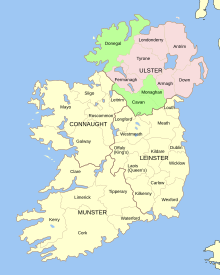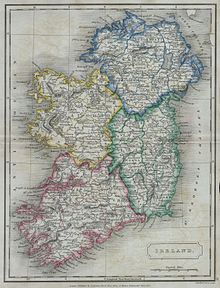Ulster Province
Ulster ( Irish Cúige Uladh [ ˈkuːgʲ ˈʊɫə ] or Ulaidh [ ˈʊɫə ]) is next to Connacht , Leinster and Munster a region and a former province in Ireland . It is located in the north of the island. Its inhabitants are called Ulter . It consisted of nine historical counties (Engl. Counties ).
structure
Ulster has an area of 21,532 km² and approximately two million people. Three of the counties - Donegal in the far northwest and Cavan and Monaghan in the interior of the island - now belong to the Republic of Ireland with a population of 325,620 . The other six counties Antrim , Armagh , Derry / Londonderry , Down , Fermanagh and Tyrone now belong to Northern Ireland and thus to the United Kingdom . Since 1972, however, Northern Ireland is no longer administratively divided into these counties, but into districts . Between 1972 and 2015 there were 26 districts. On April 1, 2015, they were grouped into eleven districts.
The legend
Ulster plays a major role in Irish mythology in what is known as the Ulster Cycle . When King Conchobor ruled Ulster, Medb and her husband, King Ailill mac Máta of Connacht, discussed which of them had the best bull in his herd. It turned out that the king had the better bull, so the queen liked an even better bull, which was only available in Ulster, the Donn Cuailnge . So messengers were sent to Conchobar, but he did not release the bull. This led to a great war which in reality was a goddess' last attempt to rule Ireland. The province of Ulster was weakened on the one hand because the king had banished the best heroes from his country and they fought on the side of the enemy, and on the other hand because Ulster was under the spell of a fairy who caused his men to be incapacitated for a time . But there was the seventeen-year-old Cuchulain , a hero who, in addition to her superhuman strength, could also change her body, so that this was a young god (a new faith). Ultimately, Cuchulain faced the enemy army or parts of it alone. In addition, his friends, the exiled heroes, fought with the enemy. Cuchulain managed to hold out the fight until the Ulster men were fit to fight again. In the end the two bulls fought against each other: the bull of Ulster won, but died of exhaustion after the fight and his return home.
history
Ulster was an Irish kingdom under the Uí Néill . In the years 1603 to 1660, after the Irish defeat against the Kingdom of England in the Nine Years' War and the associated " flight of the counts " (including Aodh Mór Ó Néill, 2nd Earl of Tyrone ) from the Irish island, English and Protestant Scots resettled in Ulster . Ulster, which has been divided since 1920, is often mistakenly used as a synonym for British Northern Ireland . In any case, Ulster plays an important role in the history of the Northern Ireland conflict. This is what the Ulster Defense Association and Ulster Volunteer Force Protestant terrorist groups , which operate across Northern Ireland, are named after the province.
Today's meaning
Today the province of Ulster is still important in the field of sports. In addition to the sports administered by the Gaelic Athletic Association ( Ulster GAA ), there is also a regional Ulster association for numerous other sports (such as Ulster Rugby for rugby union or Cycling Ulster for cycling), which includes Northern Ireland as well as the three counties in the Republic of Ireland .
See also
Individual evidence
- ^ Ingeborg Clarus: Celtic myths. Man and his otherworld. 1991, p. 158.
- ↑ English online dictionary
Web links
Coordinates: 54 ° 39 ′ N , 6 ° 38 ′ W




